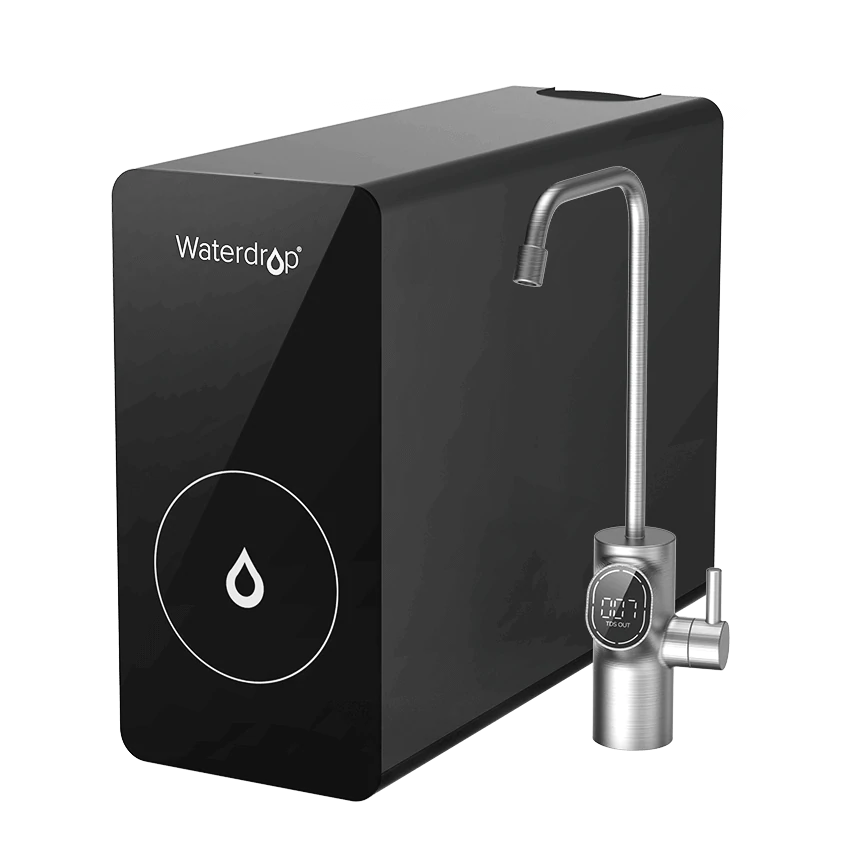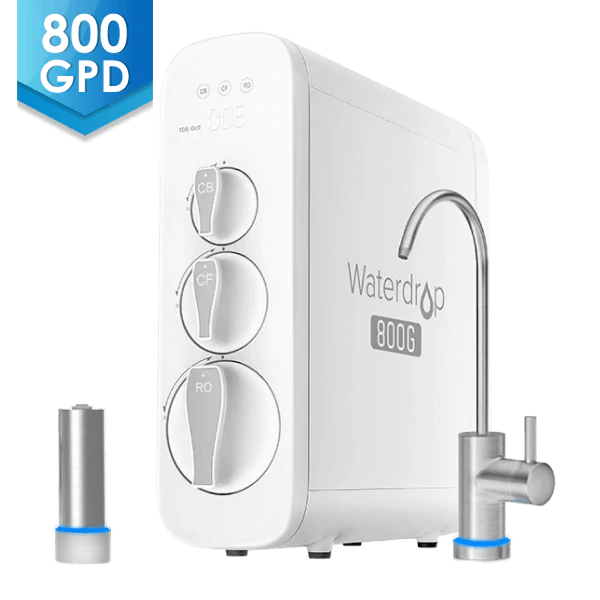Bacteria are microscopic single-celled organisms that are found everywhere on earth. Some bacteria in our water are harmful, which we call pathogenic, and cause infections, but others are harmless and even helpful to the human body. However, it is vital that harmful bacteria are removed from our water before consumption.
Reverse Osmosis can efficiently remove bacteria from your household drinking water. The water purification system uses semi-permeable membrane technology to reduce bacteria effectively. Reverse osmosis systems that also use a UV-C light, such as the Waterdrop 800GPD, are able to remove 99.9% of bacteria and viruses from water.
This article not only explains how Reverse Osmosis (RO) removes bacteria and discusses the best RO systems to use for bacteria, but also highlights the most common water-borne bacteria and symptoms. This article also covers some FAQ about bacteria in our water.
Common water-borne Bacteria
Harmful bacteria can find their way into our drinking water supply through malfunctioning wastewater treatment systems in private residences, failed septic systems, leaky sanitary sewer pipes, and sewage treatment systems that were improperly built or constructed.
The most common water-borne bacteria (and the ones people are typically concerned about) are:
- Escherichia coli
- Shigellae
- Vibrios bacteria
- Salmonella
- Burkholderia cepacia
- Mycobacterium avium complex
Causes and symptoms of water-borne illness
Drinking bacteria-contaminated water is the primary source of water-borne diseases.
Symptoms of these water-borne illnesses include diarrhea and vomiting (most common). Others have problems with the ears, eyes, skin, and respiratory system.
Preventing such illnesses is critical. Therefore, the purification of household drinking water is essential.
Reverse Osmosis does a great job of removing bacteria from drinking water.
However, the effectiveness depends on the RO unit that you choose. For example, an RO using UV light technology is vastly more effective at reducing bacteria in water than one without UV.
Similarly, using a double pass RO system has more of an effect than using a single pass RO. This is because permeate water from the first pass will pass a second purification process in a double RO giving you even purer drinking water.
How does Reverse Osmosis remove bacteria from drinking water?
Reverse Osmosis uses pressure to force contaminated or polluted water through a semi-permeable membrane. This moves the water from an area with more contaminants (high concentration) to one with fewer contaminants (low concentration).
The contaminants (in this case, bacteria) are left behind.
They are then flushed down the drain with the wastewater, while clean water passes through to the post-filters for the final purification steps.
The typical size of common bacteria, such as Escherichia coli, varies from 0.2 to 4 microns. With holes as small as 0.0001 microns, the RO membrane prevents any particle of this size to pass through it.
A typical RO system employs a 5-stage filtration process for optimal purification. The process involves the sediment pre-filter stage, carbon pre-filter, RO membrane, and post-filter. Once the contaminated water flows through the final stages, the bacteria have been effectively removed and the water is ready to drink.
Here is how the RO system works:
Stage 1: Pre-Filter for Sediment
The pre-filtration stage removes untreated tap water dust, corrosion, and debris. These pre-filters can remove impurities as fine as 5 microns in diameter.
A wide range of filters are available, but they all function similarly. When the tap water goes through the perforations in the filters, the large particulates are trapped, while water and other smaller particles like bacteria pass through.
Stage 2: Pre-filter with Carbon
The activated carbon filters absorb contaminants, encapsulating them inside its porous structure as they pass through it. This step is crucial for removing chlorine, foul odors, and PFAS, whilst improving the taste of water.
Stage 3: The Semi-Permeable Membrane
The semi-permeable reverse osmosis membrane can effectively remove over 99% of bacteria cells in tap water.
It’s the most significant component of the reverse osmosis filtering process, and it is the factor that distinguishes it from other types of water filtration.
The membrane removes heavy metals, organic compounds and any residual PFAS from the water.
Stage 4: Storage
Freshwater that has gone through the membranes goes to the reservoir for storage until it is needed.
At this time, an automated shutdown valve closes, stopping any more water from passing through the semi-permeable membrane. It also cuts off the outflow of water to the drainage. The process continues until the tank is full.
Stage 5: Post-Filtering
The filtered water then passes through another carbon filter (a polishing filter) between the storage tank and the tap. This stage ensures you get the best tasting water from the RO faucet.
Best RO system for removing bacteria
If you are looking for a product that removes bacteria, the 600GPD Under Sink Reverse Osmosis System – Waterdrop D6 is a great option.
The Waterdrop D6 prevents bacteria and virus build-up in the storage water, making it a great RO system for bacteria removal.
Note:
Bacteria are neither killed nor inactivated by reverse osmosis technology. It simply removes the microorganisms from polluted water using a semi-permeable membrane. You obtain purified water, but the filter membrane retains the biological pollutants.
Why is RO with a UV light preferable in pervasive bacterial outbreaks?
For many years, ultraviolet radiation has been routinely utilized as a germicidal treatment for drinking water. Mercury low-pressure lamps emit 254 nm ultraviolet light that is excellent for eliminating pathogenic microbes and cleaning tap water.
Ultraviolet germicidal irradiation (UVGI) is used to disinfect drinking water through the emission of radiation, which is absorbed by the DNA and proteins in the microbial cell of the bacteria.
This kills the microorganisms while leaving the water’s characteristics unchanged.
In recent years, advancements in UV lamp technology have resulted in the development of unique lamps that emit UV light at wavelengths of 185 nm and 254 nm. The UV light significantly kills harmful bacteria and has no adverse effects associated with chemical treatment.
You can use ultraviolet light with RO filters for complete bacteria removal.
The light kills the microorganisms but doesn’t physically eliminate them from the water. Therefore, by integrating UV light and RO purifiers, the bacteria are both killed and removed from the water supply.
UV systems are intended to inactivate/kill bacteria, pathogens, and other live creatures in the water but not to remove chemical impurities from the water. Reverse osmosis techniques can remove chemical pollutants from water, but they are insufficient to provide water free of microorganisms.
So it is no surprise that ultraviolet light and reverse osmosis are often used in conjunction to generate water that is very clean and safe to drink.
Some bacteria are likely to pass through the RO membrane during a pervasive bacterial outbreak. Therefore, the UV option ensures that all bacteria are inactivated/killed. This means the water will be clean even if some bacteria find their way through the membrane.
The water that comes out of the faucet is safe for consumption, even during bacteria outbreaks.
Best RO system with a UV light for removing bacteria
The Waterdrop G3P800 uses an advanced LED light chip that effectively reduces bacteria and viruses in water by up to 99.9%. This system uses LED material and is harmless compared to a mercury UV sterilizer. It functions only when water passes through, hence saving more energy.
How much Bacteria will Reverse osmosis remove?
Organic particles like viruses and bacteria are reduced at a rate of 99.9% when an RO system is operating at optimal efficiency. The membranes have a pore size of 0.0001 microns, and efficiently remove bacteria that are larger, usually in the order of 0.2-4 microns.
Similarly, RO systems can efficiently remove between 90-99% of inorganic contaminants like total dissolved solids (TDS) in the water supply. These include calcium, strontium, copper, and compounds such as Sodium Chloride, among others.
The most common bacteria and viruses removed by RO include Norovirus, Campylobacter, Shigella, E. coli, Salmonella, Hepatitis A, and Rotavirus. However, there is no guarantee that any particular pollutant will be removed entirely by a RO unit.
Therefore, combining two or more water purification systems is the best way to ensure your drinking water is 100% free of contaminants.
Does an RO system remove all Bacteria?
Reverse Osmosis is unable to remove 100% of the bacteria within a water supply. However, reverse osmosis can effectively remove up to 99.9% of bacteria.
Typically, in some circumstances where a specific bacteria is pervasive, an RO system is unable to remove it effectively. In this case, adding UV light technology is essential for all bacteria removal.
RO Systems integrated with UV light are able to kill and remove 100% of bacteria.
Can bacteria grow in reverse osmosis water?
Bacteria can grow and multiply in reverse osmosis water, just as in regular water.
It is important to note that the absence of solids in reverse osmosis water doesn’t make it sterile, and bacteria could still grow in the system. Typically, the RO storage tank provides a conducive environment for bacteria growth.
Studies show there is a possibility of bacterial growth in RO water. Therefore, one should consider post-disinfection of water from the RO system for the purest household drinking water. The post-disinfection will remove the bacteria that may have built up in the system, making the end-product pure.
However, using advanced RO systems like the Waterdrop D6 ideally mitigates this problem. The system is tankless, and reduces the chances of bacteria growth.
Does reverse osmosis remove coliform bacteria?
Reverse Osmosis systems are effective in removing coliform bacteria like E.coli. The 5-stage filtration technology used in RO systems ensures their capability to remove microorganisms and bacteria.
An RO system also removes protozoa like Cryptosporidium and viruses like Enteric and Hepatitis A.
This makes the RO system the preferred water purification unit for many households.


